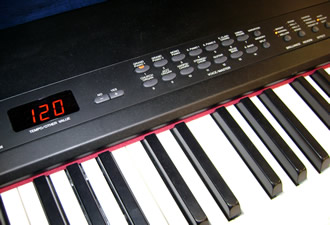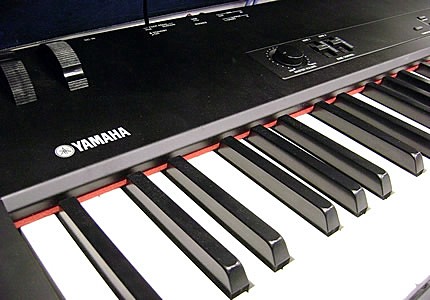
Introduction
The year was 1976 and the Yamaha CP30 Stage Piano was born. Artists such as Miles Davis and Herbie Hancock were performing their legendary music forever engraining the CP sound into the minds of millions. Since then, Yamaha introduced several more models until ultimately retiring the CP series in 1982. Now, over twenty five years later, the CP Stage Piano is back—the Yamaha CP33 and CP300 (the CP300 will be covered in detail in a future review).
Overview
Like the CP30, the CP33 is an 88-key weighted keyboard. Unlike the CP30, the CP33 is a lot more sophisticated and lighter. The CP33 uses the AWM (Advanced Wave Memory) tone generator—the same found in other professional Yamaha keyboards. The CP33 is a 64 polyphony keyboard with 28 programs, dual and split modes with dual zone sliders, mod and pitch wheels, and, an effects processor all weighing in at a mere 18kg (39lbs., 11oz).
The Yamaha CP33 keyboard is designed with the Graded Hammer 88-key weighted action—a must for serious musicians. Another great feature is the FC-3 damper pedal included with the CP33. Normally, the FC-3 damper pedal doesn't come packaged with a Yamaha keyboard or digital piano from the factory making it an item for the musician to purchase separately. However, Yamaha knew that serious musicians would appreciate a professional piano damper pedal for the CP33, and, we applaud them for including it.
Sounds
Whether you are a Pop, R&B, Jazz, or a Classical musician, you will fall in love with these pianos and more. The 28 original programs (14 instruments x 2 variations of each) were superbly sampled and exclusively designed for the CP3 series. Nothing was spared when Yamaha created these. Not only did Yamaha record these stereo dynamic piano samples at soft, medium, and hard key strikes for each note but also recorded the subtleties that are often missing in digital pianos. These include sympathetic string resonance (this effect occurs on an acoustic piano when the damper pedal is pressed while multiple strings are vibrating) and key off samples (occurs on acoustic pianos when a key is released and the damper pad comes into contact with the vibrating string).
The rest of the sounds on the CP33 are wonderful. Obviously, the CP33 wouldn't be a CP without having great electric pianos. Well, you'll find them here and won't be disappointed. There are four electrics in all that range from hammer struck metallic tines to FM (frequency modulation) synthesized—great for Pop music.
Among the other sounds are organs, a vibraphone, marimba, clavichord, harpsichord, strings & choir, nylon and steel guitars, and, electric and fretless basses.
Dual & Split Modes
The CP33 allows the user the flexibility to operate in both dual and split modes. In dual mode, you can have any two voice programs layered together. Say you wanted the grand piano and strings layered or organ and choir layered together. This mode really opens up the possibilities giving a rich palette of combinations, over 500 in all; however, that's only the beginning. You can add detuning, octave shift, and adjust the effects depth and volume for each voice.
Split mode is great for playing a melody with a particular instrument on one hand while playing the rhythm part with a different instrument on the other hand. In split mode, the Yamaha CP33 allows you to assign a split point anywhere on the keyboard and choose from any two voices. If you don't want to change the split point, the default split point is F#2. As in dual mode, split mode allows you to adjust parameters. These include the split point, right/left voice octave shift, right/left effect depth, and, sustain pedal range.
Full Featured Midi Controller
Another great feature is Master Mode. Master mode allows the musician to operate the CP33 in multi timbral mode. In a nut shell, the user can set a split point and select voices, just like in Split mode, except, each zone on the keyboard and zone sliders can also transmit to different MIDI channels. This allows you to use the CP33 as a MIDI controller controlling program changes, volume, pan, and control changes for other synthesizers and modules. You can also connect the CP33 to your DAW for complete studio integration.
Other Features
Among other features, the CP33's effect processor allows you to adjust the brilliance, choose from four reverb settings—two halls, a room, and, stage; and, choose from four effects—chorus, phaser, tremolo, and rotary speaker. The effects depth (wet/dry setting) can also be adjusted giving the musician full control over his/her sound.
Lastly, the Yamaha CP33 allows you to adjust the keyboard's touch sensitivity from light to hard. Also, there's an additional aux pedal connection for controlling various functions. The panel lock feature allows you to lockout the panel preventing unauthorized persons from changing your settings—a must have feature for live performances. There is also a click metronome adjustable from 28-280bpm, a USB connection for transmitting MIDI, and, two traditional midi ports (the midi ports are disabled if the USB connection is in use), 1/4" stereo phone jack, 1/4" L/R outputs, and AC power adapter. Not to mention, the CP33 comes with Yamaha's Rock Solid Reliance 3-year warranty covering parts and labor.
Conclusion
The CP33's acoustic/electric pianos, guitars, and organs are really something else—absolutely top notch and a must for the professional musician's arsenal. We loved the Graded Hammer keyboard action, the multi timbral capabilities, and, the FC-3 half-damper pedal that came with the CP33. We really couldn't find anything to complain about. This keyboard is a pianist's dream come true—it sounds great and is light enough to travel around with.
We recommend this keyboard for gigging and studio pianists and musicians who need a trusty digital piano that begs to be played on the road and in the studio.

